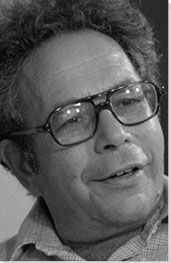Summary of George Segal
Using orthopedic bandages dipped in plaster, New York sculptor George Segal constructed some of the most haunting and memorable figurative art of the 20th century. Life-sized models based on his body and those of friends, family, and neighbors are seated at lunch counters, poised on street corners, or waiting in train stations. Like actors in a play that never starts, these figures inhabit three-dimensional environments that evoke everyday spaces. One can walk around them (which makes the effect all the more eerie) but they are lost in their own universe. It is impossible to warn them that the moment they are waiting for will never arrive. The most existential of the Pop artists, Segal gives us the opportunity to step outside the fast-paced consumer world in order to get a better look at how we function within it.
Accomplishments
- Designed to treat broken bones, the bandage is not just a medium but a metaphor. Segal's plaster cast sculptures, literally the shells of people, can be read as poignant reminders of the human toll taken by World War II. Segal was from a family of Polish Jews, most of whom perished in the Holocaust. Despite this dimension of personal significance, the strength of his work lies in the universal significance of human gesture and expression, evident in Segal's public monuments to the Gay Rights movement and The Great Depression, as well as the Holocaust.
- While plaster casts of antique busts had existed for hundreds of years, Segal's practice of dipping bandages into plaster and applying them to a live model was quite new. As he put it, "For me to decide to make a cast of a human being broke all the rules of fine art."
- An avid museumgoer and film buff, Segal was a cultural sponge. The sources that informed him range from the mysterious wrapped bodies of mummies at the Metropolitan Museum of Art to the suspenseful film noirs of the 1940s and 1950s (such as Citizen Kane).
- Segal is the most existential of the Pop artists. While other Pop artists (Warhol, Lichtenstein, Oldenburg and others) focused on logos, labels, advertisements, and other mass-produced products, Segal engages directly with the psychology of the consumer. His figures provide a window onto the human condition in a way that sets them apart from other Pop art inventions.
The Life of George Segal
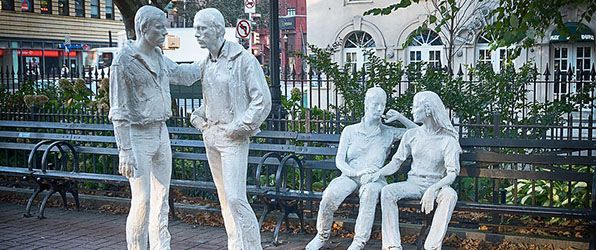
Segal Gay Liberation is a sculpture of four people near The Stonewall Inn bar in New York City that became extremely popular, and the artwork is uniquely accesible to this day - park visitors can sit right next to the sculpted figures.
Important Art by George Segal
Man at a Table
This work is the first of Segal's sculptures incorporating bandages dipped in plaster, his signature medium. Man at a Table depicts a seated, life-sized figure based on the body of the artist himself. Segal wrapped his body parts in bandages and made casts which he then reassembled to make the figure. While less attention is given to specific context here than in later sculptures, Man at a Table is evidence of the key ideas he would explore for the rest of his career. First, there is the contrast between the real (the window, chair, and table are largely unmodified by the artist) environment, and the spectral presence that inhabits it. The use of the plaster bandage calls attention to the vulnerability of the body. Finally, there is the aura of anticipation. The figure, seated alone at an empty table, appears to be waiting for something. This suspense is part of the quiet drama of Segal's everyday scenes from the early 1960s.
Plaster, wood, and glass - Collection Museum Abteiberg, Monchengladbach, West Germany
The Diner
By the mid-1960s Segal's figures and constructed environments had become more complex. Here, lit from above by a fluorescent lamp, are two figures at a realistic lunch counter. Familiar items such as coffee cups, sugar, napkin dispensers, and a coffee urn, set the stage. The objects are real; the white monochrome figures are not. They are arrested in motion, one seated and one working behind the counter. Diners, the quintessential symbol of middle-class America, had appeared in the work of numerous other artists. Where Segal goes further is in the medium itself - a life-sized restaging of the everyday event - and the mysterious, almost magical open-endedness of the moment he has chosen to capture. This could be anyone, in any diner, across the country. The theatrical aspects of the work are intensified by standing in the same space with it. In fact, this particular sculpture served as the backdrop for a 30-second promotional video in 2014 for the Walker Art Center, starring actor Danny Glover.
Plaster, wood, chrome, laminated plastic, Masonite, fluorescent lamp, glass, paper - Collection of Walker Art Center, Minneapolis, Minnesota
The Costume Party
In a radical departure from his "banal subjects" (as he himself put it), and usual matte white figures, Segal debuted as a colorist in the mid-1960s. Inspired by a real costume party he attended, this work consists of six life-size figures. The "guests" include Superman, Pussy Galore (the James Bond character), Catwoman (from Batman), and Bottom (from William Shakespeare's "Midsummer Night's Dream.") The two figures relaxing on the floor are Cleopatra and Antony. While executed in the well-known plaster cast style Segal had established, these figures are painted in vivid monochrome red, yellow, blue, and black. Also in contrast to his earlier work is the absence of a setting that confines the figures to a specific space within the gallery. The figures look as if they might walk off at any moment.
Veering in the direction of the psychedelic, this piece interjects a note of levity into an otherwise serious body of work, taking the experience from gravitas to groove. In addition, the colors employed in this work were inspired by Native American folklore. Segal had recently read Black Elk Speaks, in which the Lakota Sioux leader names the four colors of the universe as black, yellow, red, and blue. Comparable to his late emergence as a photographer, this work is evidence of Segal's interest in a diverse array of sources, approaches, and media, as well as a capacity for playfulness.
Six figures, mixed media: painted plaster, wood, glass, photo, helmet, boots - Collection of Solomon R. Guggenheim Museum, New York
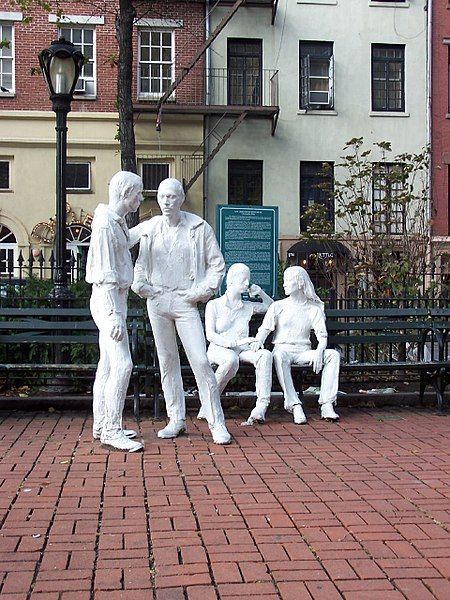
Gay Liberation
Gay Liberation, installed in 1992 in a park in Greenwich Village, commemorates a historic event that took place across the street in 1969. On June 28th of that year, New York City police raided the Stonewall Inn, a bar frequented by homosexuals. This was nothing new. What happened next was, however. Angry activists gathered in protest, demanding the decriminalization of homosexuality. Now known as the Stonewall Riot, this was the beginning of the Gay Pride movement. Created to resemble the artist's familiar plaster figures while remaining protected from the elements, these figures were cast in bronze and painted with a white lacquer. The work, commissioned in 1979 encountered resistance from the left and right that prevented it from being installed until 1992. Some pointed to its lack of diversity (both couples are Caucasian). Some felt strongly that the work should have been offered to a gay artist (Segal was straight). Some found the very idea that a public park should include a monument to homosexuality offensive. Some claimed they were not offended by the idea, but that the couples were touching in an inappropriate way. Upon examining the sculpture itself, it is evident that touch is an essential part of Segal's humanitarian approach to this human rights issue. What was at stake in The Stonewall Riots was the freedom of same sex couples to co-exist publicly and enjoy the same protections under the law. A strong example of Segal's brilliance as a designer of memorials, this once controversial work is now one of the most revered monuments in New York City.
Bronze, steel, and white lacquer - Christopher Park, New York, New York
The Holocaust
In this powerful memorial to the victims of the Holocaust, Segal employs his signature plaster cast style to evoke a concentration camp. The work was inspired by photographs taken at the end of World War II. Separated from us by a barbed wire fence, a standing man turns towards us, the viewers, and away from the heap of bodies on the ground behind him. Biblical references are present in the corpses, including one with arms outstretched like a crucified Christ, and a female figure holding a partially eaten apple (a la Eve). The standing figure is a visible manifestation of the psychic limbo in which the Holocaust survivor was caught, poised forever between the past and future and with the indelible memory of horror and loss. Segal's proposal was the winning submission for a competition for a memorial sculpture in San Francisco's Lincoln Park in 1981. While this model is made of plaster, the San Francisco sculpture is cast in bronze and painted white. It was one of Segal's first completed public commissions, and stimulated future commissions for monuments based on his plaster sculptures.
Plaster, wood, and wire - The Jewish Museum, New York
Depression Bread Line
Waiting, an overarching theme in Segal's work, is presented here with particular poignancy. Life-sized hunched and hatted men in old overcoats stand in single file beside a brick wall. Bread lines were a familiar sight during the Great Depression. The work shown here is a model for a memorial in honor of President Franklin Delano Roosevelt, whose economic policies helped lift the middle class out of poverty. Segal, who lived through this era, remembered listening with his parents to Roosevelt's "Fireside Chats" on the radio. Along with two other sculptures, entitled Fireside Chat and Appalachian Farm Couple, this sculpture was installed in 1997 in Washington, D.C. Segal's choice of an unassuming moment in everyday life maintains a connection with his earliest plaster sculptures, and is emblematic of the personal intimacy with which he portrayed historic moments. Each figure here was cast from someone he knew: four friends, and the artist himself.
Plaster, wood, metal, and acrylic paint - Collection of Crystal Bridges Museum of American Art, Bentonville, Arkansas
Hispanic Wedding Dress Display, Newark, New Jersey
While the impact of photography and photojournalism was always evident in Segal's sculptures, near the end of his career he became an active photographer. The overall achievement of Segal's photographs was to reinforce his aesthetic as a lens through which to look at the world, one that transcended medium. This photograph is part of the series of urban views of New York and New Jersey entitled Sequence: New York/New Jersey 1990-1993. In Hispanic Wedding Dress Display, Newark, New Jersey, Segal captured the shop window display of a wedding gown. In this ordinary city sight there is a kinship with the artist's earlier work: the mannequin designed for a constructed environment is a "ready-made" version of one of Segal's own sculptures. The image brings us full circle, reinforcing the ideas in his plaster figures, and demonstrating that the artist's style transcends a particular style or medium. Segal's art is a way of seeing, not just making.
Gelatin silver print - Collection of Whitney Museum of American Art, New York
Biography of George Segal
Childhood and Education
George Segal was born in New York City on November 26, 1924 to Jewish immigrants from Poland. His father, who had come to America in 1922, would lose all his brothers at the hands of the Nazis. Segal's parents ran a kosher butcher shop in the Bronx, working long hours, and dreamt of a more prosperous life for their son.
While attending public school, Segal developed a passion for art. His art teacher nurtured his love of drawing, giving him art supplies and encouraging him to explore the Metropolitan Museum of Art. Segal's high science and math scores earned him admission to Stuyvesant, one of the city's top public high schools. His parents, who had moved to New Jersey to run a chicken farm, hoped he would become a doctor or a scientist. Much to their dismay, Segal remained focused on art, living with his aunt in Brooklyn while finishing high school and spending weekends working on the chicken farm.
After graduating from high school in 1941, Segal sporadically attended a number of art schools. Due to the outbreak of World War II, his parents needed a hand on the chicken farm, which interrupted his course of study. Nonetheless, he continued to pursue his ambition to be an artist, taking courses when he could at New York's Cooper Union, Rutgers University in New Jersey (where he attended night courses), and the Pratt Institute of Design in New York. In 1949 he finally graduated with a Bachelor of Arts in art education from New York University. He would later return to Rutgers University to pursue a Master of Fine Arts which he received in 1963.
Early Training
In 1946, Segal married Helen Steinberg, a girl who lived on a neighboring farm and who he first met in his teens. They bought land across the road from his father and continued in the family business of chicken farming. His pursuit of a career in art was due in part to her unwavering support, and when the threat of bankruptcy loomed in 1957, Segal used his art education degree to get a teaching job at a New Jersey high school. There, he taught art until he was able to support himself and his family solely on his income as an artist.
Throughout his early years of struggle, Segal never wavered from his pursuit of making art and showed an early interest in painting. He and his fellow New York artist friends couldn't help but be influenced by the large-scale, color-filled paintings of the Abstract Expressionist movement that was sweeping through the New York art scene. Despite this, Segal and others in his circle were not inspired to create such works, choosing rather to create works depicting images from the real world. Many derived their inspiration from elements of popular culture and consumer images as seen in the world of advertisements, the media, and comic books; while Segal focused more on the human figure performing acts of daily life such as waiting at a station or talking on the telephone. During the 1950s Segal began to receive attention for his paintings and in 1956 he had his first solo show at the Hansa Gallery, an artist cooperative, in New York.
Mature Period
In 1961, while teaching an art class for adults, Segal discovered the substance that would become his primary medium. The husband of one of his students worked for Johnson & Johnson and asked Segal to test a new plaster bandage material and write a text about how the material could be used in art projects for children. Segal experimented with plaster, bandages, and water, manipulating and drying it into the shapes of various objects. To his excitement, Segal realized this included making casts of parts of his own body after letting the material set for only a few minutes. Inspired, Segal took the plaster casts of various parts of his body and recreated them into the form of a seated figure, incorporating objects including a table and chair to complete the work. The work, Man Sitting at a Table (1961), became the first of his plaster sculptures.
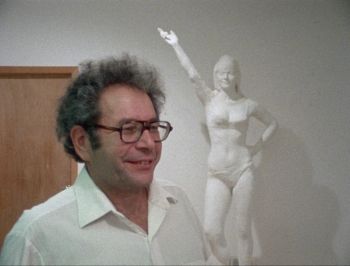
While Segal created these sculptures throughout the rest of his career, he continually experimented with different ways they could be made and refined. Moving from casts of his own body, he also used other people including his wife, friends, and eventually his daughter Rena as his models. Segal also explored the effect of adding color by painting the white plaster casts various colors and also painted some sculptures black, such as Woman Sitting on a Bed (1993) which allowed him to focus on the impact of light in a new way. Segal explored the effect of casting his sculptures in bronze and then painting the works white and also made works using only body fragments rather than depictions of the full human figure.
These plaster sculptures, which primarily depicted scenes from everyday life such as figures sitting at a diner and waiting in a station, helped to make Segal one of the leading artists of the Pop art movement. While often the subjects were engaged in some of the less exciting albeit often necessary functions of daily life, Segal also drew inspiration from popular culture. The beloved American pastime of going to the movies was referenced in his sculpture Cinema (1963) - a life-sized plaster cast figure in the act of changing a movie title on the cinema's marquee. Hollywood factored again in his sculpture The Movie Poster (1967) which featured a plaster cast man staring at a black and white photograph of iconic film star Marilyn Monroe.
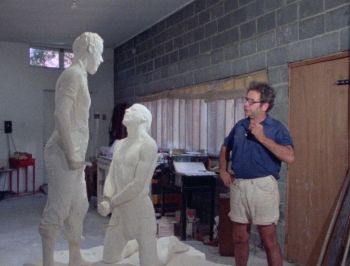
In addition to his sculptural works, Segal continued to work in a variety of other media including paint, pencil, pen and ink, and pastels. The works created included numerous themes such as close-up studies of body parts, still lifes, and portraits.
His ability to so vividly capture human figures made him a good choice to create outdoor public sculptures. This type of sculpture was becoming increasingly popular in the United States and Segal contributed works such as his sculpture The Restaurant (1976), which was placed at the Federal Office Building in Buffalo, New York. Also, he was offered the commission to create pieces commemorating important world events such as a memorial to the victims of the Holocaust and tributes to American leaders including United States President Franklin Delano Roosevelt.
Throughout his career, Segal saw exhibitions and retrospectives of his work travel through the United States and other parts of the world including an exhibition that began in Switzerland in 1971 and subsequently toured Europe; a traveling retrospective at the Walker Art Center in Minneapolis, Minnesota in 1978; a retrospective of his work in Japan in 1982; and a 1997 retrospective at the Montreal Museum of Fine Arts.
Late Period
Segal showed a renewed interest in photography later in his life. He used the photographs of people and city scenes in both New Jersey and New York as basis for some of his later sculptures and as the starting point for drawings. One of his final series, Nightscapes, began with photographs the artist took of the night lights on the US 1 highway. After returning to his studio, Segal enlarged a photograph onto plywood, painted the scene, and after cutting out holes in the plywood, placed real light bulbs where the lights were in the photograph, creating a three-dimensional recreation of his photographic captures of the highway at night. Segal remained active as an artist until his death on June 9, 2000 in South Brunswick, New Jersey.
The Legacy of George Segal
Segal's reinvigoration of the figure in art after World War II inspired numerous careers, and is part of the story of American culture taking stock of itself in the wake of unspeakable tragedies. The transition he initiated helped lead the Post-war generation back to the figure. In its focus on one or two people in an urban setting, Segal's aesthetic has roots in the American Realist paintings of the early-20th century. His unique synthesis of Realism and Pop influenced the life-sized forms and installations of Ed Kienholz, Duane Hanson, Kiki Smith and other artists working today.
Influences and Connections

-
![Meyer Schapiro]() Meyer Schapiro
Meyer Schapiro -
![Robert Rauschenberg]() Robert Rauschenberg
Robert Rauschenberg -
![Jasper Johns]() Jasper Johns
Jasper Johns ![Sidney Janis]() Sidney Janis
Sidney Janis
Useful Resources on George Segal
- George SegalOur PickBy Sam Hunter and Don Hawthorne
- George Segal: BronzeBy Joan Pachner
- George Segal (Modern Master Series)Our PickBy Phyllis Tuchman
